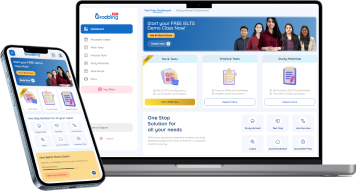The IELTS exam is conducted in two modes. One is a computer based IELTS test (CBT) and the other is paper paper-based test or PBT. It is one of the most accepted English skill tests. Students take it to prove their English language proficiency. The IELTS exam is for those who wish to study abroad or work in an English-speaking country. This blog will cover everything about the IELTS CBT and help you understand the merits and demerits of the same. Let us first start by learning what computer based IELTS tests are in the section below.

Table of Contents
This mode of IELTS exam is also known as the computer delivered IELTS. In this mode, the test takers go to the exam center and take the test on a computer system. However, they do get a page to do rough work while forming answers. Besides, it is also facilitated for people with disabilities or special needs. This makes the IELTS exam format inclusive. Besides, for both PBT and CBT IELTS, the entire test is held on the same day and at the same place. However, you may have to appear for the IELTS speaking test either before or up to 1 week after the other sections.
Also Read: IELTS General Training Task 1: Informal Letter
This was all about the IELTS CBT. Now, let us take a look at why you should opt for computer delivered IELTS instead of paper-based tests. The next section will talk about the same.
The computer based IELTS test is taken by several students and working professionals. The IELTS exam requires you to take the test at the center. As noted before, this test is also taken by people who have special needs. Here are a few more reasons to opt computer based exam over the paper based IELTS test:
Here is the entire explanation of the pointers above:
Firstly, taking the IELTS exam on a computer ensures faster checking by the evaluators. Moreover, the digitized answers will be exactly what you type. Hence, your handwriting won't be a hurdle for the examiner. The IELTS results in this mode are released within 2 days of taking the test.
Secondly, the dates to conduct the computer based IELTS exam at every test center will be more. Therefore, opting for the CD IELTS mode of the exam will be feasible and flexible. You can choose from a variety of dates from any month.
You can copy and paste lines from the text while answering the questions. Moreover, the IELTS computer based test also facilitates you to highlight text and make notes while reading passages. Besides, you also get a pen and paper for rough use.
Also Read: 50 + Synonyms to Use in IELTS Exam
While doing the writing task of the IELTS writing test, you must keep track of the word count. Moreover, these tasks are also evaluated on the basis of how you stick to the word limit of each task and present your ideas well.
These are the reasons for taking the computer based test for IELTS. Now, let us know the difference between the computer-based IELTS exam and the paper based mode.
This section will talk about how the CD IELTS mode is different from the paper based mode. The table below will discuss each pointer in detail:
| COMPUTER BASED IELTS TEST | PAPER BASED IELTS TEST |
|---|---|
| This mode ensures faster results. That, with in 2 days of taking the exam. | The results in this mode are presented 13 days after taking the test. |
| Allows typing answers and gives a facility to take digital notes. | It involves traditional writing only. Hence, a good handwriting has to be maintained. |
| You can apply to register for this mode using the computer icon. | You have to use the paper icon while registering for a paper based IELTS exam. |
These were the differences between the computer based IELTS test and the paper-delivered IELTS. Now, let us know about the advantages and disadvantages of the IELTS exam. The section below will state the pros and cons of IELTS CBT with regard to every section.
Also Read: Double Question Essay in IELTS
Here are a few pointers to explain to you the merits and demerits of taking the IELTS computer based test:
Also Read: How to Send IELTS Scores to Universities?
These are the several pros and cons of writing IELTS on a computer. Now, let us know more about the general advice for the IELTS exam.
Also Read: IELTS Test Report Format
You will find a range of useful advice in this section to clear the IELTS computer based test on your first attempt.
To sum up, the IELTS exam is not tough if your preparation is up to the mark. These were the advice an expert will give you for your computer based IELTS test. Go through them and practice from the right resources. You can contact experienced IELTS experts to get training for passing the exam. You can also access their IELTS mock test computer based. Moreover, their customized study plans for different types of learners can be very helpful too.
The candidates with needs like breastfeeding and other medical conditions are given extra time. Moreover, for the hearing impaired, there is a lip-reading version of the IELTS listening test. Besides, these facilities are also available to those who opt for paper based test.
The IELTS CBT and PBT tests, both have the same exam format. Thus, the listening, reading, speaking, and writing sections have the same number of questions, and the time given to take each of them is also the same. Below is the IELTS test format:
There are several benefits of taking the IETLS CBT test over the paper based test. These are the flexibility of choosing the test date and day along with faster results. The test results for CBT test takers get released within 2 days of taking the test.
The IELTS exam is 2 hours and 45 minutes. Both the CBT and the paper based test are of the same time duration.
To ace the IELTS CBT test in one go, it is essential to practice well. Here are some tips you can use to study for IETLS at home:

We are available in :
BangaloreAhmedabadJaipurHyderabadKeralaPuneChandigarhMumbaiGurgaonChennaiKolkataTrivandrumNoidaKochiCalicutKottayamKollamThrissurIndoreUdaipurdisclaimer:logos and other registered trademarks of universities used on this platform are held by their respective owners. Gradding does not claim ownership or association on them, and their use is purely for informational and illustrative purposes.


